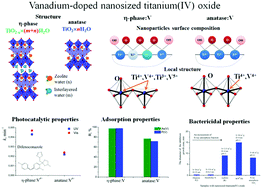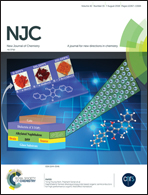The role of composition and structure of vanadium-doped nanosized titanium(iv) oxides (anatase and η-phase) in the realization of photocatalytic, adsorption and bactericidal properties
Abstract
Samples containing vanadium-doped nanosized titanium(IV) oxides with anatase and η-phase structures were prepared by a modified sulfate process, and samples with vanadium-doped η-phase were prepared for the first time. The bulk and the surface of the samples were characterized by a lot of methods, including X-ray diffraction, diffuse reflectance spectroscopy, X-ray absorption spectroscopy (EXAFS/XANES), X-ray photoelectron spectroscopy (XPS), and scanning electron microscopy (SEM). The photocatalytic activity (PCA) of the samples was studied in the reaction of photodegradation of the cationic dye rhodamine 6G (in the visible region) and the systemic triazole fungicide difenoconazole (in the UV and visible regions). The PCA was found to be influenced by the phase composition of the samples, the composition of their surface, and nanosized titanium(IV) oxide modifications. Vanadium-doped samples with η-phase containing different ions (Ti3+, Ti4+, V4+, and V5+) and reactive OH groups on the nanoparticle surface exhibited the highest PCA. The samples were shown to have a higher adsorption capacity (AC) for the extraction of As(V) (the highest AC in the presence of vanadium-doped anatase and η-phase) and P(V) (the highest AC in the presence of undoped anatase and η-phase) anions from aqueous systems. The adsorption capacity correlates with the amount of reactive OH groups on the nanoparticle surface and does not depend on the modification of the adsorbent. Only vanadium-doped anatase containing the largest fraction of an amorphous component and the largest amount of SO42− groups on its nanoparticle surface exhibits antimicrobial activity against Staphylococcus aureus, Escherichia coli, and Bacillus anthracoides. Vanadium doped anatase and η-phase can be used to purify aquatic environments of harmful organic pollutants and a wide range of anions.



 Please wait while we load your content...
Please wait while we load your content...